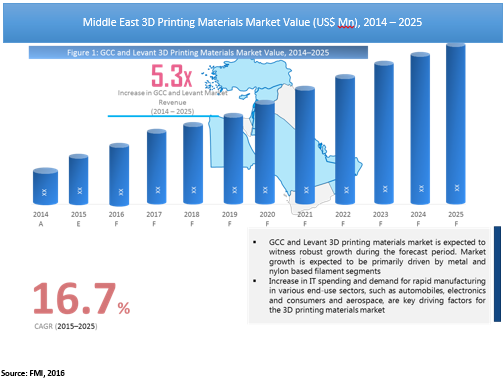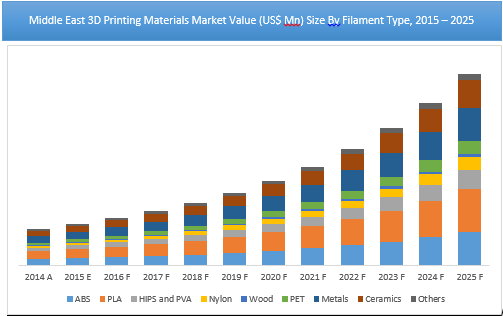FMI Market Report: The Middle East is Going to See Dramatic Growth in the 3D Printing Materials Market
 Every day brings a fresh flow of news from the 3D printing industry, and while it’s easy enough to spot and follow major trends, there’s so much out there that it’s hard to get a look at the overall big picture. Which areas of the world are leading in which sectors? Where is the most growth actually happening? Thankfully there are organizations that exist to provide us with a wide-angle look at the 3D printing industry and the directions in which it is likely to head. Future Market Insights (FMI) is always a reliable source for insights into fast-growing sectors such as the 3D bioprinting industry, and now they’ve taken a look at the wide world of 3D printing materials in a new report entitled 3D Printing Materials Market: Dynamic Proliferation of Technology Across Multiple Manufacturing Industries over the Coming Years: Middle East Industry Analysis and Opportunity Assessment, 2015-2025.
Every day brings a fresh flow of news from the 3D printing industry, and while it’s easy enough to spot and follow major trends, there’s so much out there that it’s hard to get a look at the overall big picture. Which areas of the world are leading in which sectors? Where is the most growth actually happening? Thankfully there are organizations that exist to provide us with a wide-angle look at the 3D printing industry and the directions in which it is likely to head. Future Market Insights (FMI) is always a reliable source for insights into fast-growing sectors such as the 3D bioprinting industry, and now they’ve taken a look at the wide world of 3D printing materials in a new report entitled 3D Printing Materials Market: Dynamic Proliferation of Technology Across Multiple Manufacturing Industries over the Coming Years: Middle East Industry Analysis and Opportunity Assessment, 2015-2025.
As that mouthful of a title makes clear, the report’s major focus is on the Middle Eastern region. We’ve taken a look at 3D printing in the Middle East before, and while the region as a whole has been relatively slow to adopt the technology, FMI is confident that that’s going to change, and change quickly. The report predicts that the market for 3D printing materials in the Middle East will grow at over 16% per year, and within a decade will have surpassed $550 million in revenue.
The report notes that the manufacturing sector in the GCC region, which is comprised of the Kingdom of Saudi Arabia (KSA), United Arab Emirates (UAE), Oman, Qatar, Kuwait and Bahrain, has been adopting 3D printing technology at a Compound Annual Growth Rate of about 11% – higher than the average global adoption rate. The UAE, which has been one exception to the slow 3D printing growth rate with its focus on advanced technology – and particularly green technology – has been leading this charge, and FMI predicts the country will continue to dominate the GCC market. The Levant region, encompassing Cyprus, Egypt, Turkey, Israel, Jordan, Syria, Palestine, and Iraq, Israel (another prolific exception) is expected to lead with a CAGR of 20.4%.
So what accounts for the upward growth predictions in the Middle Eastern 3D printing materials industry? According to the FMI report:
“Growth of the Middle East 3D printing materials market is mainly driven by low cost production output along with emergence of new supply chain and retail opportunities in the region. For instance, many e-Retailers are selling 3D printed products online owing to increased demand. These e-Retailers have minimized supply chain gap between 3D printed product manufacturers and end-users, which is expected to boost overall sales of 3D printing materials. Moreover, setting up of various 3D printing manufacturing units, along with emergence of many 3D printing technology-based start-ups in the region, is expected to bolster overall growth of the industrial manufacturing sector in the Middle East regions. Transition from conventional printing techniques to 3D printing can help manufacturers cut down overall operational costs by almost 50%.”
Health care is also a factor. 3D printing is now playing such a major role in the health care industry that it’s almost impossible to advance without it, and the FMI report estimates that the medical industry will grow at about 13.4% CAGR over the forecast period. Strong demand from the automotive and aerospace industries is also expected to contribute.
Broken down by material, PLA, unsurprisingly, is expected to come out as the winner with a projected growth rate of 16.7% – largely due to its widespread use in medical applications.
Key players in the Middle Eastern 3D printing market are likely to include:
Several prominent companies are working to increase their presence in the Middle East through partnerships and collaborations with local retailers. Also contributing to the rise of 3D printing are several government initiatives implemented to encourage the spread of new manufacturing technologies. You can access the entire report here. What are your thoughts on this information? Discuss in the 3D Printing Materials in the Middle East forum over at 3DPB.com.
Subscribe to Our Email Newsletter
Stay up-to-date on all the latest news from the 3D printing industry and receive information and offers from third party vendors.
You May Also Like
3D Printing News Unpeeled: A $3000 SLS System, Construction Subsidies and Parameters
The Housing Affordability Crisis is one of Canadian President Trudeau’s biggest issues. Now the government has made subsidies available, including scaling new technologies, 3D printed housing and libraries of reapproved...
“Bundled Light” Enables High Quality Plastic 3D Printing from LEAM
Naturally, we expect current 3D printing methods to continuously improve, but it continues to do so in the most surprising ways. The latest development comes from LEAM, a startup spun...
Each to Their Own: Exploring Creality’s Latest Ender Trio as the Company Strengthens Its Commitment to 3D Printing Advocacy
Creality has reaffirmed its commitment to promoting 3D printing. The launch of the Ender-3 V3 SE, Ender-3 V3 KE, and Ender-3 V3 showcases the company’s dedication to catering to diverse...
3D Printing News Briefs, March 23, 2024: AM in the US Coast Guard, Navy, & More
In today’s 3D Printing News Briefs, we’re discussing the use of 3D printing in various branches of the military, including the U.S. Coast Guard, the U.S. Navy, and the German...

































